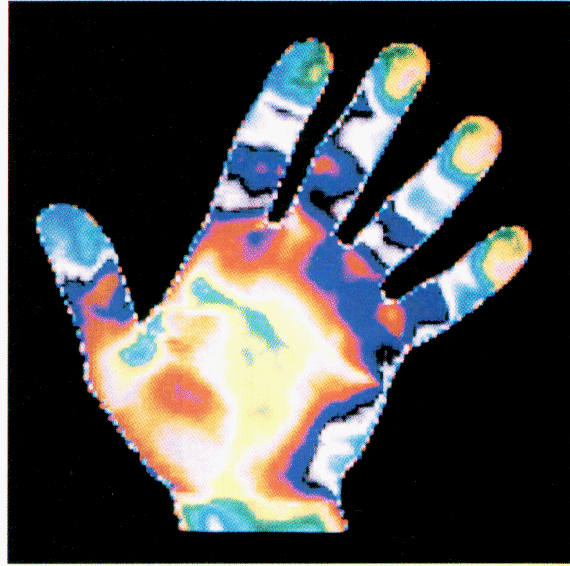
An image of a human hand taken in the infrared displayed in false color where white and yellow correspond to hot regions, blue and green to cool regions.

An image of a human hand taken in the infrared displayed in false color where white and yellow correspond to hot regions, blue and green to cool regions.
Infrared Radiation:
Beyond the red end of the visible range, but at frequencies higher than those of radar waves and microwaves, is the infrared region of the electromagnetic spectrum. William Herschel, a German-born British musician and self-taught astronomer, discovered this form of radiation in 1800 by exploring, with the aid of a thermometer, sunlight dispersed into its colors by a glass prism. Infrared radiation is absorbed and emitted by the rotations and vibrations of chemically bonded atoms or groups of atoms and thus by many kinds of materials. For instance, window glass that is transparent to visible light absorbs infrared radiation by the vibration of its constituent atoms. Infrared radiation is strongly absorbed by water and by the atmosphere. Although invisible to the eye, infrared radiation can be detected as warmth by the skin. Nearly 50 percent of the Sun's radiant energy is emitted in the infrared region of the electromagnetic spectrum, with the rest primarily in the visible region.
Atmospheric haze and certain pollutants that scatter visible light are nearly transparent to parts of the infrared spectrum because the scattering efficiency increases with the fourth power of the frequency. Infrared photography of distant objects from the air takes advantage of this phenomenon. For the same reason, infrared astronomy enables researchers to observe cosmic objects through large clouds of interstellar dust that scatter infrared radiation substantially less than visible light. However, since water vapour, ozone, and carbon dioxide in the atmosphere absorb large parts of the infrared spectrum most infrared astronomical observations are carried out at high altitude by balloons, rockets, or spacecraft.
An infrared photograph of a landscape enhances objects according to their heat emission: blue sky and water appear nearly black, whereas green foliage and unexposed skin show up brightly. Infrared photography can reveal pathological tissue growths (thermography) and defects in electronic systems and circuits due to their increased emission of heat.
The infrared absorption and emission characteristics of molecules and materials yield important information about the size, shape, and chemical bonding of molecules and of atoms and ions in solids. The energies of rotation and vibration are quantized in all systems. The infrared radiation energy emitted or absorbed by a given molecule or substance is therefore a measure of the difference of some of the internal energy states. These in turn are determined by the atomic weight and molecular bonding forces. For this reason, infrared spectroscopy is a powerful tool for determining the internal structure of molecules and substances or, when such information is already known and tabulated, for identifying the amounts of those species in a given sample. Infrared spectroscopic techniques are often used to determine the composition and hence the origin and age of archaeological specimens and for detecting forgeries of art and other objects, which, when inspected under visible light, resemble the originals.
Infrared radiation plays an important role in heat transfer and is integral to the so-called greenhouse effect (see above The greenhouse effect of the atmosphere), influencing the thermal radiation budget of the Earth on a global scale and affecting nearly all biospheric activity. Virtually every object at the Earth's surface emits electromagnetic radiation primarily in the infrared region of the spectrum.
Instruments for detecting infrared radiation include heat-sensitive devices such as thermocouple detectors, bolometers (some of these are cooled to temperatures close to absolute zero so that the thermal radiation of the detector system itself is greatly reduced), photovoltaic cells, and photoconductors. The latter are made of semiconductor materials (e.g., silicon and lead sulfide) whose electrical conductance increases when exposed to infrared radiation.
Excerpt from the Encyclopedia Britannica without permission.